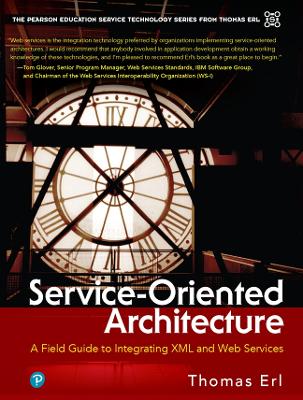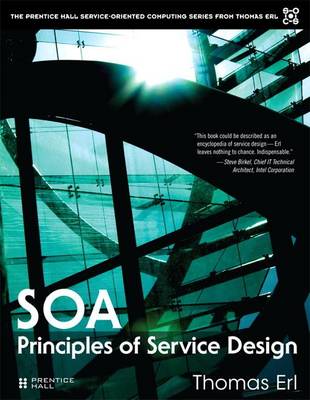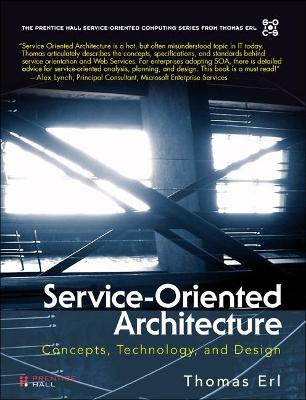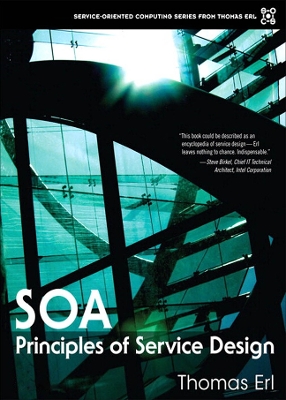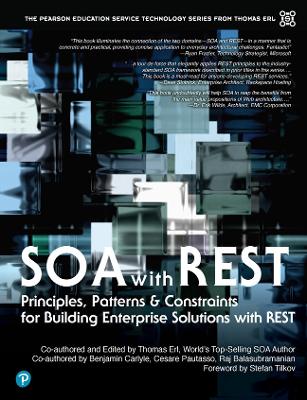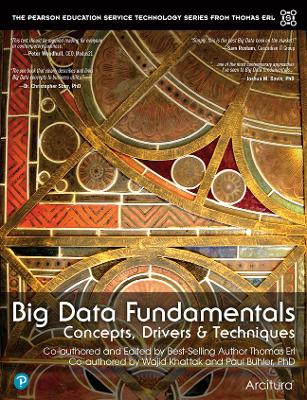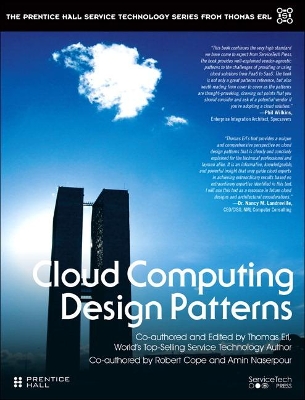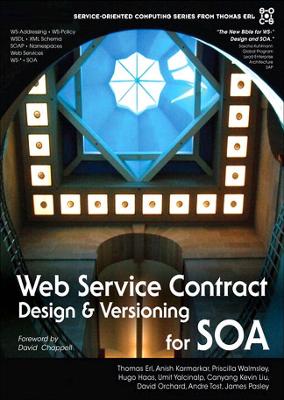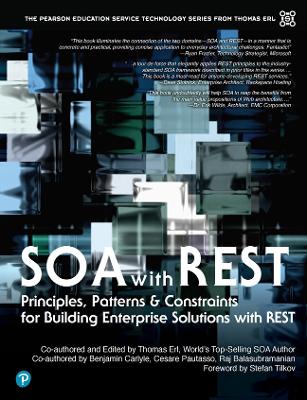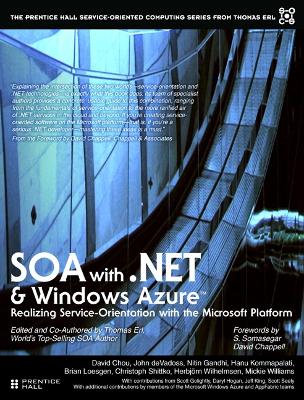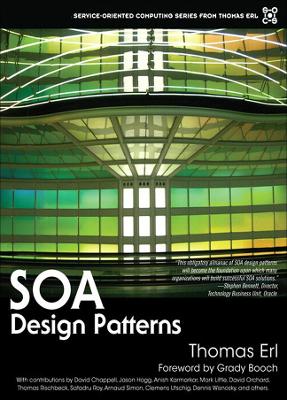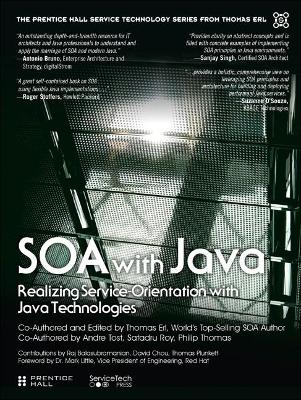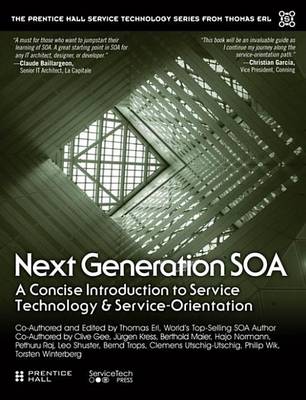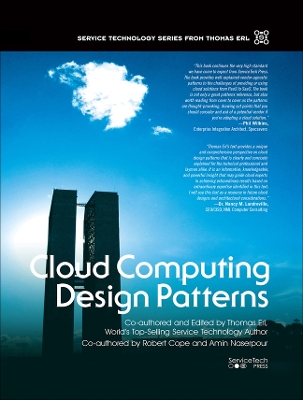The Pearson Service Technology Series from Thomas Erl
17 total works
As XML becomes an increasingly significant part of the IT mainstream, expert guidance and common-sense strategies are required to avoid the many pitfalls of applying XML incorrectly or allowing it to be used in an uncontrolled manner. This book acts as a knowledge base for issues relating to integration, and provides clear, concise advice on how to best determine the manner and direction XML technology should be positioned and integrated. The book will be one of the first to provide documentation for second-generation Web services technologies (also known as WS-*). The importance of these specifications (which include BPEL, WS-Transaction, WS-Coordination, WS-Security, WS-Policy, and WS-Reliable Messaging) cannot be understated. Major standards organizations and vendors are supporting and developing these standards. ***David Keogh, Program Manager for Enterprise Frameworks and Tools, Microsoft, will provide a front cover quotation for the book.
The key to succeeding with service-oriented architecture (SOA) is in comprehending the meaning and significance of its most fundamental building block: the service. It is through an understanding of service design that truly “service-oriented” solution logic can be created in support of achieving the strategic goals associated with SOA and service-oriented computing. Bestselling SOA author Thomas Erl guides you through a comprehensive, insightful, and visually rich exploration of the service-orientation design paradigm, revealing exactly how services should and should not be designed for real-world SOA.
This book’s in-depth coverage includes
Over 240 full-color illustrations.
A concise introduction to SOA and service-oriented computing concepts and benefits.
A thorough exploration of the service-orientation design paradigm as represented by eight specific design principles.
A comparison of service-oriented and object-oriented concepts and principles and a clear definition of what qualifies as “service-oriented” logic.
Detailed coverage of four different forms of service-related design granularity.
An exhaustive examination of service contracts, with an emphasis on standardization, abstraction, and the utilization of WS-Policy, XML Schema, and WSDL definitions.
A comprehensive study of positive and negative service-related coupling types with an emphasis on the requirements to attaining a suitable level of loose coupling.
An inside look into how commercial design approaches are incorporated to achieve truly agnostic and reusable service logic.
Techniques for maximizing service reliability, scalability, and performance by instilling high levels of autonomy and emphasizing stateless design.
Approaches for positioning services as highly discoverable and interpretable enterprise resources.
Unprecedented coverage of how to design services for participation in complex compositions.
The definition of concrete links between each design principle and the strategic goals and benefits of SOA and service-oriented computing.
Numerous cross-references to key design patterns documented separately in SOA: Design Patterns.
—Alex Lynch, Principal Consultant, Microsoft Enterprise Services
"One primary objective of applying SOA in design is to provide business value to the solutions we build. Understanding the right approach to analyzing, designing, and developing service-oriented solutions is critical. Thomas has done a great job of demystifying SOA in practical terms with his book."
—Rick Weaver, IBM Senior Consulting Certified SW I/T Specialist
"A pragmatic guide to SOA principles, strategy, and best practices that distills the hype into a general framework for approaching SOA adoption in complex enterprise environments."
—Sameer Tyagi, Senior Staff Engineer, Sun Microsystems
"A very timely and much needed contribution to a rapidly emerging field. Through clarifying the principles and nuances of this space, the author provides a comprehensive treatment of critical key aspects of SOA from analysis and planning to standards ranging from WS-specifications to BPEL. I'll be recommending this book to both clients and peers who are planning on embracing SOA principles."
—Ravi Palepu, Senior Field Architect, Rogue Wave Software
"Finally, an SOA book based on real implementation experience in production environments. Too many SOA books get lost in the technical details of Web Services standards, or simply repeat vendor hype. This book covers the really hard parts: the complex process of planning, designing and implementing service-oriented architectures that meet organizational goals. It is an essential companion to any software developer, architect, or project manager implementing—or thinking about implementing—a service-oriented architecture."
—Priscilla Walmsley, Managing Director of Datypic
"Thomas Erl's Service-Oriented Architecture: Concepts, Technology, and Design is as good an introduction to service-oriented architectures as one could wish for. In a single volume, it covers the entire topic, from theory to real-world use to technical details. The examples are superb and the writing is wonderfully clear."
—Ronald Bourret, Author, "XML and Databases"
"Finally an SOA book which gets to the point with real world answers and examples. Erl guides you on a real world SOA journey. From architecture design to industry standards, this book is well written and can be easily referenced for everyday use. When embarking on your own service orientated adventures, this is the book you want in your bag."
—Clark Sell, Vice President, CSell Incorporated
"Organizations struggling to evolve existing service-oriented solutions beyond simple Web Services now have an expert resource available. Leading the way to the true service-oriented enterprise, Thomas Erl demystifies the complexities of the open WS-I standards with detailed practical discussions and case studies. Erl's depth and clarity makes this work a superb complement to his Field Guide."
—Kevin P. Davis, PhD., Software Architect
"This book is an excellent guide for architects, developers, and managers who are already working with or are considering developing Web Services or Service-Oriented Architecture solutions. The book is divided into four sections. In the first section the fundamental technologies of XML, Web Services and Service-Oriented Architectures are described in detail with attention given to emerging standards. The book is well written and very thorough in its coverage of the subject. I recommend this book highly to anyone interested in enterprise level service architectures."
—Adam Hocek, President and CTO, Broadstrokes, Inc.
Additional praise quotes are published at: www.soabooks.com/reviews.asp
The foremost "how-to" guide to SOA
Service-Oriented Architecture (SOA) is at the heart of a revolutionary computing platform that is being adopted world-wide and has earned the support of every major software provider. In Service-Oriented Architecture: Concepts, Technology, and Design, Thomas Erl presents the first end-to-end tutorial that provides step-by-step instructions for modeling and designing service-oriented solutions from the ground up.
Erl uses more than 125 case study examples and over 300 diagrams to illuminate the most important facets of building SOA platforms: goals, obstacles, concepts, technologies, standards, delivery strategies, and processes for analysis and design.
His book's broad coverage includes
Detailed step-by-step processes for service-oriented analysis and service-oriented design
An in-depth exploration of service-orientation as a distinct design paradigm, including a comparison to object-orientation
A comprehensive study of SOA support in .NET and J2EE development and runtime platforms
Descriptions of over a dozen key Web services technologies and WS-* specifications, including explanations of how they interrelate and how they are positioned within SOA
The use of "In Plain English" sections, which describe complex concepts through non-technical analogies
Guidelines for service-oriented business modeling and the creation of specialized service abstraction layers
A study contrasting past architectures with SOA and reviewing current industry influences
Project planning and the comparison of different SOA delivery strategies
The goal of this book is to help you attain a solid understanding of what constitutes contemporary SOA along with step-by-step guidance for realizing its successful implementation.
About the Web Sites
Erl's Service-Oriented Architecture books are supported by two Web sites. http://www.soabooks.com provides a variety of content resources and http://www.soaspecs.com supplies a descriptive portal to referenced specifications.
© Copyright Pearson Education. All rights reserved.
–Steve Birkel, Chief IT Technical Architect, Intel Corp.
“An absolute pleasure to read…the best SOA book I’ve read.
A book I would recommend to all of my colleagues; it provides much insight to the topics often overlooked by most books in this genre…the visuals were fantastic.”
–Brandon Bohling, SOA Architecture and Strategy, Intel Corporation
“This book is a milestone in SOA literature. For the first time we are provided with a practical guide on defining service characteristics and service design principles for SOA from a vendor-agnostic viewpoint. It’s a great reference for SOA discovery, adoptions, and implementation projects.”
–Canyang Kevin Liu, Principal Enterprise Architect, SAP Americas, Inc.
“I liked this book. It contains extremely important material for those who need to design services.”
–Farzin Yashar, IBM SOA Advanced Technologies
“This book does a great job laying out benefits, key ideas and design principles behind successfully adopting service-oriented computing. At the same time, the book openly addresses challenges, risks and trade-offs that are in the way of adopting SOA in the real-world today. It moves away from ivory-tower views of service orientation, but still lays out a strong vision for SOA and outlines the changes necessary to realize the full potential.”
–Christoph Schittko, Senior Architect, Microsoft
“I recommend this book to any SOA practitioner who wishes to empower themselves in making service design real…gives readers the 360º view into service design [and] gives SOA practitioners the depth and understanding needed into the principles of SOA to assist in the design of a mature and successful SOA program.”
–Stephen G. Bennett, Americas SOA Practice Lead, BEA Systems
“SOA projects are most successful when they are based on a solid technical foundation. Well accepted and established design principles are part of this foundation. This book takes a very structured approach at defining the core design principles for SOA, thus allowing the reader to immediately applying them to a project. Each principle is formally introduced and explained, and examples are given for how to apply it to a real design problem. A ‘must read’ for any architect, designer or developer of service oriented solutions”.
–Andre Tost, Senior Technical Staff Member, IBM Software Group
“There are few references for SOA that give you the nuts and bolts and this one is at the top of the list. Well written and valuable as a reference book to any SOA practitioner.”
–Dr. Mohamad Afshar, Director of Product Management, Oracle Fusion Middleware, Oracle Corporation
“A thorough examination of the considerations of service design. Both seasoned SOA practitioners and those endeavoring to realize services can benefit from reading this book.”
–Bill Draven, Enterprise Architect, Intel Corporation
“There are very few who understand SOA like Thomas Erl does! The principle centric description of service orientation from Thomas canonizes the underpinnings of this important paradigm shift in creating agile and reusable software capabilities. The principles, so eloquently explained, leave little room for any ambiguity attached to the greater purpose of SOA. Most organizations today are creating services in a bottoms-up approach, realizing composition and reuse organically. The time is ripe for a book like this that prepares architects for a principle centric approach to SOA.”
–Hanu Kommalapati, Architect, Microsoft Corporation
“Outstanding SOA literature uniquely focused on the fundamental services design with thorough and in-depth study on all practical aspects from design principles to methodologies. This book provides a systematic approach for SOA adoption essential for both IT management and professionals.”
–Robin Chen, PhD, Google, Inc.
“Thomas Erl’s books are always densely filled with information that’s well structured. This book is especially insightful for Enterprise Architects because it provide s great context and practical examples. Part 1 of the book alone is worth getting the book for.”
–Markus Zirn, Senior Director, Product Management, Oracle Fusion Middleware, Oracle Corporation
“A very clear discussion of the subject matter. Provides a good structure that facilitates understanding and readily highlights key points.”
–Kareem Yusuf, Director of SOA Strategy and Planning, IBM Software Group
“I am very impressed. Comprehensive. Educative. This book helped me to step back and look at the SOA principles from broader perspective. I’d say this is a must-read book for SOA stakeholders.”
–Radovan Janecek, Director R&D, SOA Center, Hewlett-Packard
“Very valuable guidance for understanding and applying SOA service design principles with concrete examples. A must read for the practitioner of SOA service design.”
–Umit Yalcinalp, PhD, Standards Architect, SAP
“This book really does an excellent job of explaining the principles underpinning the value of SOA…Erl goes to great length to explain and give examples of each of the 8 principles that will significantly increase the readers ability to drive an SOA service design that benefits both business and IT.”
–Robert Laird, IT Architect, IBM EAI/SOA Advanced Technologies Group
“This book strikes a healthy balance between theory and practice. It is a perfect complement to the SOA series by the author.”
–Prakash Narayan, Sun Microsystems
“If you are going to be designing, developing, or implementing SOA, this is a must have book.”
–Jason “AJ” Comfort Sr., Booz Allen Hamilton
“An excellent book for anyone who wants to understand service-orientation and the principles involved in designing services…a clear, concise and articulate exploration of the eight design principles involved in analyzing, designing, implementing, and maintaining services…”
–Anish Karmarkar, Oracle Corporation
“Very well written, succinct, and easy to understand.”
–Raj Balasubramanian, IBM Software Group
“Acomprehensive exploration of the issues of service design which has the potential to become the definitive work in this area.”
–James Pasley, Chief Technology Officer, Cape Clear Software
“An excellent addition to any SOA library; it covers a wide range of issues in enough detail to be a valuable asset to anyone considering designing or using SOA based technologies.”
–Mark Little, Director of Standards, Red Hat
“This book communicates complex concepts in a clear and concise manner. Examples and illustrations are used very effectively.”
–Darryl Hogan, Senior Architect, Microsoft
“A work of genius…Offers the most comprehensive and thorough explanation on the principles of service design and what it means to be ‘service oriented.’
“Erl’s treatment of the complex world of service oriented architecture is pragmatic, inclusive of real world situations and offers readers ways to communicate these ideas through illustrations and well formulated processes.”
–David Michalowicz, MITRE Corporation
“This is the book for the large organization trying to rationalize its IT assets and establish an agile platform for the future. By highlighting risk and rewards, Thomas Erl brings clarity to how Service Orientation can be applied to ensure a responsive IT organization. This book finally brings software engineering principles to address the real world development challenges being faced.
To effectively serve the business, let alone embrace SOA, everyone involved should be familiar with the concepts investigated here. Thomas Erl thoroughly clarifies the nuances and defines the practice of service design.
We expect that this will become a classic text in software engineering, corporate training
and colleges.”
–Cory Isaacson, President, Rogue Wave Software and Ravi Palepu, SOA Author and Speaker
“Thomas Erl does a great job…an easy read.”
–Michael H. Sor, Booz Allen Hamilton
“…a must read for SOA Architects to develop a firm foundation and understanding of the principles (and trade-offs) that make up a good SOA service.
After reading this book, it finally ‘clicked’ as to why a properly designed SOA system is different (and better) than a system based on previous enterprise architectures.”
–Fred Ingham, Platinum Solutions Inc.
“Lays a tremendous foundation for business and technical workers to come to common terms and expectations…incredibly enlightening to see the details associated with achieving the SOA vision.”
–Wayne P. Ariola, Vice President of Strategy, Parasoft
“[Erl does] and excellent job of addressing the breadth of [his] audience to present to those new to SOA and weaved in enough detail to assist those who are already actively involved in SOA development.”
–R. Perry Smith, Application Program Manager, EDS/OnStar
“It is easy to miss the big picture of what SOA means for the design of larger scale systems amidst the details of WS technologies. Erl helps provide a broader perspective, surveying the landscape from a design standpoint.”
–Jim Clune, Chief Architect, Parasoft
“Lays a firm foundation for the underlying principles of good service design. Cuts through the hype and provides a cogent resource for improving architectural judgment on SOA projects.”
–Jim Murphy, Vice President of Product Management, Mindreef, Inc.
“The first book to concisely, gradually and comprehensively explain how to apply SOA principles into enterprise-level software design. It is an excellent book.”
–Robin G. Qiu, Ph.D., Division of Engineering and Information Science, Pennsylvania State University
“I really think that this is a very useful book that a lot of people really need out there in the industry.”
–Dr. Arnaud Simon, Principal Software Engineer, Red Hat
“…indispensable companion to designing and implementing a service-oriented architecture. It condenses all information necessary to design services and is the most relevant source I know if in the field.”
“[This book is] not only helpful, but fundamental to successfully designing an SOA.”
–Phillipp Offermann, Research Analyst, University of Berlin
“Service-Oriented Architecture is an important topic in IT today. Its vast scope could span an organization’s enterprise. Designing it properly is a major undertaking. This book provides timely, expert and comprehensive discussions on the principles of service design. Thomas has a keen sense in identifying the subtle points of various subjects and explains them in an easy-to-understand way. The book is a valuable resource for IT professionals working in SOA.”
–Peter H. Chang, PhD, Associate Professor of Information Systems, Lawrence Technological University
The Definitive Guide to Service Engineering
The key to succeeding with service-oriented architecture (SOA) is in comprehending the meaning and significance of its most fundamental building block: the service. It is through an understanding of service design that truly “service-oriented” solution logic can be created in support of achieving the strategic goals associated with SOA and service-oriented computing. Bestselling SOA author Thomas Erl guides you through a comprehensive, insightful, and visually rich exploration of the service-orientation design paradigm, revealing exactly how services should and should not be designed for real-world SOA.
This book’s in-depth coverage includes
Over 240 full-color illustrations.
A concise introduction to SOA and service-oriented computing concepts and benefits.
A thorough exploration of the service-orientation design paradigm as represented by eight specific design principles.
A comparison of service-oriented and object-oriented concepts and principles and a clear definition of what qualifies as “service-oriented” logic.
Detailed coverage of four different forms of service-related design granularity.
An exhaustive examination of service contracts, with an emphasis on standardization, abstraction, and the utilization of WS-Policy, XML Schema, and WSDL definitions.
A comprehensive study of positive and negative service-related coupling types with an emphasis on the requirements to attaining a suitable level of loose coupling.
An inside look into how commercial design approaches are incorporated to achieve truly agnostic and reusable service logic.
Techniques for maximizing service reliability, scalability, and performance by instilling high levels of autonomy and emphasizing stateless design.
Approaches for positioning services as highly discoverable and interpretable enterprise resources.
Unprecedented coverage of how to design services for participation in complex compositions.
The definition of concrete links between each design principle and the strategic goals and benefits of SOA and service-oriented computing.
Numerous cross-references to key design patterns documented separately in SOA: Design Patterns.
www.prenhallprofessional.com
www.soabooks.com
www.soasystems.com
Preface xxv
Chapter 1: Introduction 1
Chapter 2: Case Study Background 19
Part I: Fundamentals
Chapter 3: Service-Oriented Computing and SOA 25
Chapter 4: Service-Orientation 67
Chapter 5: Understanding Design Principles 103
Part II: Design Principles
Chapter 6: Service Contracts (Standardization and Design) 125
Chapter 7: Service Coupling (Intra-Service and Consumer Dependencies) 163
Chapter 8: Service Abstraction (Information Hiding and Meta Abstraction Types) 211
Chapter 9: Service Reusability (Commercial and Agnostic Design) 253
Chapter 10: Service Autonomy (Processing Boundaries and Control) 293
Chapter 11: Service Statelessness (State Management Deferral and Stateless Design) 325
Chapter 12: Service Discoverability (Interpretability and Communication) 361
Chapter 13: Service Composability (Composition Member Design and Complex Compositions) 387
Part III: Supplemental
Chapter 14: Service-Orientation and Object-Orientation: A Comparison of Principles and Concepts 445
Chapter 15: Supporting Practices 477
Chapter 16: Mapping Service-Orientation Principles to Strategic Goals 497
Appendices
Appendix A: Case Study Conclusion 513
Appendix B: Process Descriptions 517
Appendix C: Principles and Patterns Cross-Reference 529
Additional Resources 533
About the Author 535
About the Photos 537
Index 539
SOA with REST
by Thomas Erl, Benjamin Carlyle, Cesare Pautasso, and Raj Balasubramanian
The Definitive Guide to Building Web-Centric SOA with REST
The World Wide Web is based on the most successful technology architecture in history. It has changed how we view, access, and exchange information and, with the advent of REST, it has also provided us with compelling ways to build and improve automation solutions. REST provides a great deal of guidance to ensure that an architecture and its automation logic are technically sound, though it is still your responsibility to build services that actually add value to your business.
SOA with REST is the first comprehensive tutorial and reference for designing and building RESTful services as part of service-oriented solutions and in conjunction with service-oriented architecture (SOA). This book demonstrates that REST is not only a suitable medium for building truly service-oriented solutions, but also that the service-oriented architectural model is a necessary foundation for REST technology architectures to realize their full business potential.
The authors provide thorough mapping of REST constraints and architectural goals with service-orientation principles and SOA characteristics. Using real-world examples, they show how to leverage REST’s simplicity, flexibility, and low overhead without compromising the power or manageability of service-oriented solutions and architectures.
This ebook will be valuable to IT architects, developers, and any practitioner seeking to use SOA and REST together.
In Cloud Computing: Concepts, Technology & Architecture, Thomas Erl, one of the world’s top-selling IT authors, teams up with cloud computing experts and researchers to break down proven and mature cloud computing technologies and practices into a series of well-defined concepts, models, technology mechanisms, and technology architectures, all from an industry-centric and vendor-neutral point of view. In doing so, the book establishes concrete, academic coverage with a focus on structure, clarity, and well-defined building blocks for mainstream cloud computing platforms and solutions.
Subsequent to technology-centric coverage, the book proceeds to establish business-centric models and metrics that allow for the financial assessment of cloud-based IT resources and their comparison to those hosted on traditional IT enterprise premises. Also provided are templates and formulas for calculating SLA-related quality-of-service values and numerous explorations of the SaaS, PaaS, and IaaS delivery models.
With more than 260 figures, 29 architectural models, and 20 mechanisms, this indispensable guide provides a comprehensive education of cloud computing essentials that will never leave your side.
--Peter Woodhull, CEO, Modus21
“The one book that clearly describes and links Big Data concepts to business utility.”
--Dr. Christopher Starr, PhD
“Simply, this is the best Big Data book on the market!”
--Sam Rostam, Cascadian IT Group
“...one of the most contemporary approaches I’ve seen to Big Data fundamentals...”
--Joshua M. Davis, PhD
The Definitive Plain-English Guide to Big Data for Business and Technology Professionals
Big Data Fundamentals provides a pragmatic, no-nonsense introduction to Big Data. Best-selling IT author Thomas Erl and his team clearly explain key Big Data concepts, theory and terminology, as well as fundamental technologies and techniques. All coverage is supported with case study examples and numerous simple diagrams.
The authors begin by explaining how Big Data can propel an organization forward by solving a spectrum of previously intractable business problems. Next, they demystify key analysis techniques and technologies and show how a Big Data solution environment can be built and integrated to offer competitive advantages.
- Discovering Big Data’s fundamental concepts and what makes it different from previous forms of data analysis and data science
- Understanding the business motivations and drivers behind Big Data adoption, from operational improvements through innovation
- Planning strategic, business-driven Big Data initiatives
- Addressing considerations such as data management, governance, and security
- Recognizing the 5 “V” characteristics of datasets in Big Data environments: volume, velocity, variety, veracity, and value
- Clarifying Big Data’s relationships with OLTP, OLAP, ETL, data warehouses, and data marts
- Working with Big Data in structured, unstructured, semi-structured, and metadata formats
- Increasing value by integrating Big Data resources with corporate performance monitoring
- Understanding how Big Data leverages distributed and parallel processing
- Using NoSQL and other technologies to meet Big Data’s distinct data processing requirements
- Leveraging statistical approaches of quantitative and qualitative analysis
- Applying computational analysis methods, including machine learning
Cloud Computing Design Patterns
by Thomas Erl, Robert Cope, and Amin Naserpour
-- Phil Wilkins, Enterprise Integration Architect, Specsavers
“Thomas Erl’s text provides a unique and comprehensive perspective on cloud design patterns that is clearly and concisely explained for the technical professional and layman alike. It is an informative, knowledgeable, and powerful insight that may guide cloud experts in achieving extraordinary results based on extraordinary expertise identified in this text. I will use this text as a resource in future cloud designs and architectural considerations.”
-- Dr. Nancy M. Landreville, CEO/CISO, NML Computer Consulting
The Definitive Guide to Cloud Architecture and Design
Best-selling service technology author Thomas Erl has brought together the de facto catalog of design patterns for modern cloud-based architecture and solution design. More than two years in development, this book’s 100+ patterns illustrate proven solutions to common cloud challenges and requirements. Its patterns are supported by rich, visual documentation, including 300+ diagrams.
The authors address topics covering scalability, elasticity, reliability, resiliency, recovery, data management, storage, virtualization, monitoring, provisioning, administration, and much more. Readers will further find detailed coverage of cloud security, from networking and storage safeguards to identity systems, trust assurance, and auditing.
This book’s unprecedented technical depth makes it a must-have resource for every cloud technology architect, solution designer, developer, administrator, and manager.
Topic Areas
- Enabling ubiquitous, on-demand, scalable network access to shared pools of configurable IT resources
- Optimizing multitenant environments to efficiently serve multiple unpredictable consumers
- Using elasticity best practices to scale IT resources transparently and automatically
- Ensuring runtime reliability, operational resiliency, and automated recovery from any failure
- Establishing resilient cloud architectures that act as pillars for enterprise cloud solutions
- Rapidly provisioning cloud storage devices, resources, and data with minimal management effort
- Enabling customers to configure and operate custom virtual networks in SaaS, PaaS, or IaaS environments
- Efficiently provisioning resources, monitoring runtimes, and handling day-to-day administration
- Implementing best-practice security controls for cloud service architectures and cloud storage
- Securing on-premise Internet access, external cloud connections, and scaled VMs
- Protecting cloud services against denial-of-service attacks and traffic hijacking
- Establishing cloud authentication gateways, federated cloud authentication, and cloud key management
- Providing trust attestation services to customers
- Monitoring and independently auditing cloud security
- Solving complex cloud design problems with compound super-patterns
Web Service Contract Design and Versioning for SOA
by Thomas Erl, Anish Karmarkar, Priscilla Walmsley, Hugo Haas, L Umit Yalcinalp, Kevin Liu, David Orchard, Andre Tost, and James Pasley
The Ultimate Guide for Designing and Governing Web Service Contracts
For Web services to succeed as part of SOA, they require balanced, effective technical contracts that enable services to be evolved and repeatedly reused for years to come. Now, a team of industry experts presents the first end-to-end guide to designing and governing Web service contracts. Writing for developers, architects, governance specialists, and other IT professionals, the authors cover the following areas:
Understanding Web Service Contract Technologies
Initial chapters and ongoing supplementary content help even the most inexperienced professional get up to speed on how all of the different technologies and design considerations relate to the creation of Web service contracts. For example, a visual anatomy of a Web service contract documented from logical and physical perspectives is provided, along with a chapter dedicated to describing namespaces in plain English. The book is further equipped with numerous case study examples and many illustrations.
Fundamental and Advanced WSDL
Tutorial coverage of WSDL 1.1 and 2.0 and detailed descriptions of their differences is followed by numerous advanced WSDL topics and design techniques, including extreme loose coupling, modularization options, use of extensibility elements, asynchrony, message dispatch, service instance identification, non-SOAP HTTP binding, and WS-BPEL extensions. Also explained is how WSDL definitions are shaped by key SOA design patterns.
Fundamental and Advanced XML Schema
XML Schema basics are covered within the context of Web services and SOA, after which advanced XML Schema chapters delve into a variety of specialized message design considerations and techniques, including the use of wildcards, reusability of schemas and schema fragments, type inheritance and composition, CRUD-style message design, and combining industry and custom schemas.
Fundamental and Advanced WS-Policy
Topics, such as Policy Expression Structure, Composite Policies, Operator Composition Rules, and Policy Attachment establish a foundation upon which more advanced topics, such as policy reusability and centralization, nested, parameterized, and ignorable assertions are covered, along with an exploration of creating concurrent policy-enabled contracts and designing custom policy assertions and vocabularies.
Fundamental Message Design with SOAP
A broad range of message design-related topics are covered, including SOAP message structures, SOAP nodes and roles, SOAP faults, designing custom SOAP headers and working with industry-standard SOAP headers.
Advanced Message Design with WS-Addressing
The art of message design is taken to a new level with in-depth descriptions of WS-Addressing endpoint references (EPRs) and MAP headers and an exploration of how they are applied via SOA design patterns. Also covered are WSDL binding considerations, related MEP rules, WS-Addressing policy assertions, and detailed coverage of how WS-Addressing relates to SOAP Action values.
Advanced Message Design with MTOM, and SwA
Developing SOAP messages capable of transporting large documents or binary content is explored with a documentation of the MTOM packaging and serialization framework (including MTOM-related policy assertions), together with the SOAP with Attachments (SwA) standard and the related WS-I Attachments Profile.
Versioning Techniques and Strategies
Fundamental versioning theory starts off a series of chapters that dive into a variety of versioning techniques based on proven SOA design patterns including backward and forward compatibility, version identification strategies, service termination, policy versioning, validation by projection, concurrency control, partial understanding, and versioning with and without wildcards.
Web Service Contracts and SOA
The constant focus of this book is on the design and versioning of Web service contracts in support of SOA and service-orientation. Relevant SOA design principles and design patterns are periodically discussed to demonstrate how specific Web service technologies can be applied and further optimized. Furthermore, several of the advanced chapters provide expert techniques for designing Web service contracts while taking SOA governance considerations into account.
About the Web Sites
www.soabooks.com supplements this book with a variety of resources, including a diagram symbol legend, glossary, supplementary articles, and source code available for download.
www.soaspecs.com provides further support by establishing a descriptive portal to XML and Web services specifications referenced in all of Erl’s Service-Oriented Architecture books.
Foreword
Preface
Chapter 1: Introduction
Chapter 2: Case Study Background
Part I: Fundamental Service Contract Design
Chapter 3: SOA Fundamentals and Web Service Contracts
Chapter 4: Anatomy of a Web Service Contract
Chapter 5: A Plain English Guide to Namespaces
Chapter 6: Fundamental XML Schema: Types and Message Structure Basics
Chapter 7: Fundamental WSDL Part I: Abstract Description Design
Chapter 8: Fundamental WSDL Part II: Concrete Description Design
Chapter 9: Fundamental WSDL 2.0: New Features, and Design Options
Chapter 10: Fundamental WS-Policy: Expression, Assertion, and Attachment
Chapter 11: Fundamental Message Design: SOAP Envelope Structure, and Header Block Processing
Part II: Advanced Service Contract Design
Chapter 12: Advanced XML Schema Part I: Message Flexibility, and Type Inheritance and Composition
Chapter 13: Advanced XML Schema Part II: Reusability, Derived Types, and Relational Design
Chapter 14: Advanced WSDL Part I: Modularization, Extensibility, MEPs, and Asynchrony
Chapter 15: Advanced WSDL Part II: Message Dispatch, Service Instance Identification, and Non-SOAP HTTP Binding
Chapter 16: Advanced WS-Policy Part I: Policy Centralization and Nested, Parameterized, and Ignorable Assertions
Chapter 17: Advanced WS-Policy Part II: Custom Policy Assertion Design, Runtime Representation, and Compatibility
Chapter 18: Advanced Message Design Part I: WS-Addressing Vocabularies
Chapter 19: Advanced Message Design Part II: WS-Addressing Rules and Design Techniques
Part III: Service Contract Versioning
Chapter 20: Versioning Fundamentals
Chapter 21: Versioning WSDL Definitions
Chapter 22: Versioning Message Schemas
Chapter 23: Advanced Versioning
Part IV: Appendices
Appendix A: Case Study Conclusion
Appendix B: A Comparison of Web Services and REST Services
Appendix C: How Technology Standards are Developed
Appendix D: Alphabetical Pseudo Schema Reference
Appendix E: SOA Design Patterns Related to This Book
SOA with REST
by Thomas Erl, Benjamin Carlyle, Cesare Pautasso, and Raj Balasubramanian
“This book illuminates the connection of the two domains--SOA and REST--in a manner that is concrete and practical, providing concise application to everyday architectural challenges. Fantastic!”
--Ryan Frazier, Technology Strategist, Microsoft
“...a tour de force that elegantly applies REST principles to the industry-standard SOA framework described in prior titles in this series.... This book is a must-read for anyone developing REST services.”
--Dave Slotnick, Enterprise Architect, Rackspace Hosting
“This book undoubtedly will help SOA to reap the benefits from the main value propositions of Web architecture....”
--Dr. Erik Wilde, Architect, EMC Corporation
“REST is so much more than just another type of interface implementation--SOA with REST shows how the ecosystem of service compositions changes as new opportunities arise for service composition architecture designs. A comprehensive guide and a must-read for any serious IT architect considering REST-style services for application architectures.”
--Roger Stoffers, Solution Architect, Hewlett Packard
“Service-orientation and REST both are architectural styles that are cornerstones of modern applications and cloud computing. Both aim to deliver scalable, interoperable solutions, but their different roots don’t always make them a natural fit. SOA with REST explains how the two styles can work together in enterprise environments. It discusses a design process for a services portfolio that meets the goals of SOA and at the same time designs services that comply with the established REST constraints. It also shows pragmatic approaches to meet enterprise-grade requirements with the REST programming style but relaxes constraints where necessary.”
--Christoph Schittko, Director of Cloud Strategy, Microsoft
“An excellent repertoire of service-oriented patterns that will prove handy when solving problems in the real world. The REST perspectives and principles will provide complete coverage of modern-day Web 2.0 style approaches. Highly recommended.”
--Sid Sanyal, IT Architect, Zurich Financial Services
“An inspirational book that provides deep insight into the design and development of next-generation service-oriented systems based on the use of REST. This book clarifies the convergence of SOA and REST with no-nonsense content that addresses common questions and issues head-on. An essential ‘instrument of modern service implementation’ and a powerful body of knowledge for software designers, architects, and consultants.”
--Pethuru Raj, Ph.D., Enterprise Architecture (EA) Consultant, Wipro Consulting Services
“REST and SOA are two of the most misunderstood terms in the software industry over the past decade. Yet the REST architectural style coupled with modern RESTful framework implementations provides a scalable and reliable approach to SOA. This book covers all you need to know about how to take the principles of REST and apply them in small and large SOA developments. If you are familiar with REST and thinking about SOA, then you need this book. If you have not considered REST in your SOA work, then this book is for you, too. Covering concepts of both REST and SOA, as well as design patterns and when to use them, the book is a wonderful companion and a good tool for architects and engineers.”
--Dr. Mark Little, CTO JBoss, Red Hat
“Unlike many other texts on the subject, SOA with REST is a well-rounded, easy-to-read narrative, including real-world case studies that appeal to both developers and analysts. This makes it an indispensable source for any SOA practitioner or any professional who is planning to initiate an SOA project.”
--Theodore T. Morrison, Certified SOA Analyst, CSM, Geocent, LLC
“SOA and REST are two very important architectural styles for distributed computing. SOA is successfully adopted by most enterprises, and the REST style is getting more attention from both researcher and industry users. The book SOA with REST introduces a new architectural style that is ingeniously combining both SOA and REST styles and clearly reveals how SOA and REST can work together to generate successful enterprise SOA strategies with REST, along with guidance for making architecture design decisions. This book is a bible of best practices for designing and implementing SOA architecture with REST. It is a must-have reference book for both IT practitioners and researchers.”
--Longji Tang, FedEx IT Senior Technical Advisor, Ph.D. in CSSE
The Definitive Guide to Building Web-Centric SOA with REST
The World Wide Web is based on the most successful technology architecture in history. It has changed how we view, access, and exchange information and, with the advent of REST, it has also provided us with compelling ways to build and improve automation solutions. REST provides a great deal of guidance to ensure that an architecture and its automation logic are technically sound, though it is still your responsibility to build services that actually add value to your business.
SOA with REST is the first comprehensive tutorial and reference for designing and building RESTful services as part of service-oriented solutions and in conjunction with service-oriented architecture (SOA). This book demonstrates that REST is not only a suitable medium for building truly service-oriented solutions, but also that the service-oriented architectural model is a necessary foundation for REST technology architectures to realize their full business potential.
The authors provide thorough mapping of REST constraints and architectural goals with service-orientation principles and SOA characteristics. Using real-world examples, they show how to leverage REST’s simplicity, flexibility, and low overhead without compromising the power or manageability of service-oriented solutions and architectures.
This book will be valuable to IT architects, developers, and any practitioner seeking to use SOA and REST together.
Topic Areas
- Distributed solution design with HTTP and REST
- REST-based service composition architectures
- REST service modeling and a service-oriented analysis process for REST service candidates
- Technical service contract notation for REST services based on a uniform contract
- Designing REST service contracts with service-orientation
- Understanding REST constraints in relation to service-orientation principles
- Using hypermedia and dynamic binding within SOA and service compositions
- Creating complex HTTP-based methods for enterprise solutions
- Advanced design techniques, including composition deepening, runtime logic deferral, and dynamic binding with common properties
- Cross-service transactions and event-driven messaging with REST
- Addressing enterprise solution concerns in relation to REST-based state management
- Applying SOA design patterns to REST-based solutions
- Distinguishing REST and SOA service concepts and terminology
- Designing REST architectures with SOA
- Versioning REST services and uniform contracts
- Fundamental REST, SOA, and service-orientation concepts and terminology
- REST constraints, REST architectural goals, and properties
- Seven new REST-inspired design patterns
- Defining common goals of REST and SOA
SOA with .NET and Windows Azure
by Thomas Erl, David Chou, John deVadoss, Nitin Gandhi, Hanu Kommalapati, Brian Loesgen, Christoph Schittko, Herbj?rn Wilhelmsen, Mickey Williams, and Scott Golightly
In SOA with .NET and Windows Azure, top Microsoft technology experts team up with Thomas Erl to explore service-oriented computing with Microsoft’s latest .NET service technologies and Windows Azure innovations.
The authors provide comprehensive documentation of on-premise and cloud-based modern service technology advancements within the Microsoft platform and further show how these technologies have increased the potential for applying and realizing service-orientation practices and goals.
Specifically, the book delves into Microsoft enterprise technologies, such as:
- Windows Communication Foundation (WCF)
- Windows Azure
- Windows Workflow Foundation (WF)
- Windows Azure AppFabric
- BizTalk Server
- Windows Presentation Foundation (WPF)
...as well as industry service mediums, including WS-* and REST, and many related service industry standards and technologies.
The book steps through common SOA design patterns and service-orientation principles, along with numerous code-level examples that further detail various technology architectures and implementations.
“SOA Design Patterns is an important contribution to the literature and practice
of building and delivering quality software-intensive systems.”
- Grady Booch, IBM Fellow
“With the continued explosion of services and the increased rate of adoption of SOA through the market, there is a critical need for comprehensive, actionable guidance that provides the fastest possible time to results. Microsoft is honored to contribute to the SOA Design Patterns book, and to continue working with the community to realize the value of Real World SOA.”
- Steven Martin, Senior Director, Developer Platform Product Management, Microsoft
“SOA Design Patterns provides the proper guidance with the right level of abstraction to be adapted to each organization’s needs, and Oracle is pleased to have contributed to the patterns contained in this book.”
- Dr. Mohamad Afshar, Director of Product Management, Oracle Fusion Middleware, Oracle
“Red Hat is pleased to be involved in the SOA Design Patterns book and contribute important SOA design patterns to the community that we and our customers have used within our own SOA platforms. I am sure this will be a great resource for future SOA practitioners.”
- Pierre Fricke Director, Product Line Management, JBoss SOA Platform, Red Hat
“A wealth of proven, reusable SOA design patterns, clearly explained and illustrated with examples. An invaluable resource for all those involved in the design of service-oriented solutions.”
- Phil Thomas, Consulting IT Specialist, IBM Software Group
“This obligatory almanac of SOA design patterns will become the foundation on which many organizations will build their successful SOA solutions. It will allow organizations to build their own focused SOA design patterns catalog in an expedited fashion knowing that it contains the wealth and expertise of proven SOA best practices.”
- Stephen Bennett, Director, Technology Business Unit, Oracle Corporation
“The technical differences between service orientation and object orientation are subtle
enough to confuse even the most advanced developers. Thomas Erl’s book provides a great service by clearly articulating SOA design patterns and differentiating them from similar OO design patterns.”
- Anne Thomas Manes, VP & Research Director, Burton Group
“SOA Design Patterns does an excellent job of laying out and discussing the areas of SOA design that a competent SOA practitioner should understand and employ.”
- Robert Laird, SOA Architect, IBM
“As always, Thomas delivers again. In a well-structured and easy-to-understand way, this book provides a wonderful collection of patterns each addressing a typical set of SOA design problems with well articulated solutions. The plain language and hundreds of diagrams included in the book help make the complicated subjects of SOA design comprehensible even to those who are new to the SOA design world. It’s a must-have reference book for all SOA practitioners, especially for enterprise architects, solution architects, developers, managers, and business process experts.”
- Canyang Kevin Liu, Solution Architecture Manager, SAP
“The concept of service oriented architecture has long promised visions of agile organizations being able to swap out interfaces and applications as business needs change. SOA also promises incredible developer and IT productivity, with the idea that key services would be candidates for cross-enterprise sharing or reuse. But many organizations’ efforts to move to SOA have been mired–by organizational issues, by conflicting vendor messages, and by architectures that may amount to little more than Just a Bunch of Web Services. There’s been a lot of confusion in the SOA marketplace about exactly what SOA is, what it’s supposed to accomplish, and how an enterprise goes about in making it work.
SOA Design Patterns is a definitive work that offers clarity on the purpose and functioning of service oriented architecture. SOA Design Patterns not only helps the IT practitioner lay the groundwork for a well-functioning SOA effort across the enterprise, but also connects the dots between SOA and the business requirements in a very concrete way. Plus, this book is completely technology agnostic—SOA Design Patterns rightly focuses on infrastructure and architecture, and it doesn’t matter whether you’re using components of one kind or another, or Java, or .NET, or Web services, or REST-style interfaces.
While no two SOA implementations are alike, Thomas Erl and his team of contributors have effectively identified the similarities in composition services need to have at a sub-atomic level in order to interact with each other as we hope they will. The book identifies 85 SOA design patterns which have been developed and thoroughly vetted to ensure that a service-oriented architecture does achieve the flexibility and loose coupling promised. The book is also compelling in that it is a living document, if you will, inviting participation in an open process to identify and formulate new patterns to this growing body of knowledge.”
- Joe McKendrick, Independent Analyst, Author of ZDNet’s SOA Blog
“If you want to truly educate yourself on SOA, read this book.”
- Sona Srinivasan, Global Client Services & Operations, CISCO
“An impressive decomposition of the process and architectural elements that support serviceoriented analysis, design, and delivery. Right-sized and terminologically consistent.
Overall, the book represents a patient separation of concerns in respect of the process and architectural parts that underpin any serious SOA undertaking. Two things stand out. First, the pattern relationship diagrams provide rich views into the systemic relationships that structure a service-oriented architecture: these patterns are not discrete, isolated templates to be applied mechanically to the problem space; rather, they form a network of forces and constraints that guide the practitioner to consider the task at hand in the context of its inter-dependencies. Second, the pattern sequence diagrams and accompanying notes provide a useful framework for planning and executing the many activities that comprise an SOA engagement.”
- Ian Robinson, Principal Technology Consultant, ThoughtWorks
“Successful implementation of SOA principles requires a shift in focus from software system means, or the way capabilities are developed, to the desired end results, or real-world effects required to satisfy organizational business processes. In SOA Design Patterns, Thomas Erl provides service architects with a broad palette of reusable service patterns that describe service capabilities that can cut across many SOA applications. Service architects taking advantage of these patterns will save a great deal of time describing and assembling services to deliver the real world effects they need to meet their organization’s specific business objectives.”
- Chuck Georgo, Public Safety and National Security Architect
“In IT, we have increasingly come to see the value of having catalogs of good solution patterns in programming and systems design. With this book, Thomas Erl brings a comprehensive set of patterns to bear on the world of SOA. These patterns enable easily communicated, reusable, and effective solutions, allowing us to more rapidly design and build out the large, complicated and interoperable enterprise SOAs into which our IT environments are evolving.”
- Al Gough, Business Systems Solutions CTO, CACI International Inc.
“This book provides a comprehensive and pragmatic review of design issues in service-centric design, development, and evolution. The Web site related to this book [SOAPatterns.org] is a wonderful platform and gives the opportunity for the software community to maintain this catalogue….”
- Veronica Gacitua Decar, Dublin City University
“Erl’s SOA Design Patterns is for the IT decision maker determined to make smart architecture design choices, smart investments, and long term enterprise impact. For those IT professionals committed to service-orientation as a value-added design and implementation option, Patterns offers a credible, repeatable approach to engineering an adaptable business enterprise. This is a must read for all IT architect professionals.”
- Larry Gloss, VP and General Manager, Information Manufacturing, LLC
“These SOA patterns define, encompass, and comprise a complete repertoire of best practices for developing a world-class IT SOA portfolio for the enterprise and its organizational units through to service and schema analysis and design. After many years as an architect on many SOA projects, I strongly recommend this book be on the shelf of every analyst and technical member of any SOA effort, right next to the SOA standards and guidelines it outlines and elucidates the need for. Our SOA governance standards draw heavily from this work and others from this series.”
- Robert John Hathaway III, Enterprise Software Architect, SOA Object Systems
“A wise man once told me that wisdom isn’t all about knowledge and intelligence, it is just as much about asking questions. Asking questions is the true mark of wisdom and during the writing of the SOA Design Patterns book Thomas Erl has shown his real qualities. The community effort behind this book is huge meaning that Thomas has had access to the knowledge and experience of a large group of accomplished practitioners. The result speaks for itself. This book is packed with proven solutions to recurring problems, and the documented pros and cons of each solution have been verified by persons with true experience. This book could give SOA initiatives of any scale a real boost.”
- Herbjörn Wilhelmsen, Architect and Senior Consultant, Objectware
“This book is an absolute milestone in SOA literature. For the first time we are provided with a practical guide on how the principle centric description of service orientation from a vendor-agnostic viewpoint is actually made to work in a language based on patterns. This book makes you talk SOA! There are very few who understand SOA like Thomas Erl does, he actually put’s it all together!”
- Brian Lokhorst, Solution Architect, Dutch Tax Office
“Service oriented architecture is all about best practices we have learned since IT’s existence. This book takes all those best practices and bundles them into a nice pattern catalogue. [It provides] a really excellent approach as patterns are not just documented but are provided with application scenarios through case studies [which] fills the gap between theory and practice.”
- Shakti Sharma, Senior Enterprise Architect, Sysco Corp
“An excellent and important book on solving problems in SOA [with a] solid structure. Has the potential of being among the major influential books.”
- Peter Chang, Lawrence Technical University
“SOA Design Patterns presents a vast amount of knowledge about how to successfully implement SOA within an organization. The information is clear, concise, and most importantly, legitimate.”
- Peter B. Woodhull, President and Principal Architect, Modus21
“SOA Design Patterns offers real insights into everyday problems that one will encounter when investing in services oriented architecture. [It] provides a number of problem descriptions and offers strategies for dealing with these problems. SOA design patterns highlights more than just the technical problems and solutions. Common organizational issues that can hinder progress towards achieving SOA migration are explained along with potential approaches for dealing with these real world challenges. Once again Thomas Erl provides in-depth coverage of SOA terminology and helps the reader better understand and appreciate the complexities of migrating to an SOA environment.”
- David Michalowicz, Air and Space Operations Center Modernization Team Lead,
MITRE Corporation
“This is a long overdue, serious, comprehensive, and well-presented catalog of SOA design patterns. This will be required reading and reference for all our SOA engineers and architects. The best of the series so far!
[The book] works in two ways: as a primer in SOA design and architecture it can easily be read front-to-back to get an overview of most of the key design issues you will encounter, and as a reference catalog of design techniques that can be referred to again and again…”
- Wendell Ocasio, Architecture Consultant, DoD Military Health Systems, Agilex Technologies
“Thomas has once again provided the SOA practitioner with a phenomenal collection of
knowledge. This is a reference that I will come back to time and time again as I move forward in SOA design efforts.
What I liked most about this book is its vendor agnostic approach to SOA design patterns. This approach really presents the reader with an understanding of why or why not to implement a pattern, group patterns, or use compound patterns rather than giving them a marketing spiel on why one implementation of a pattern is better than another (for example, why one ESB is better than another). I think as SOA adoption continues to advance, the ability for architects to understand when and why to apply specific patterns will be a driving factor in the overall success and evolution of SOA. Additionally, I believe that this book provides the consumer with the understanding required to chose which vendor’s SOA products are right for their specific needs.”
- Bryan Brew, SOA Consultant, Booz Allen Hamilton
“A must have for every SOA practitioner.”
- Richard Van Schelven, Principal Engineer, Ericsson
“This book is a long-expected successor to the books on object-oriented design patterns and integration patterns. It is a great reference book that clearly and thoroughly describes design patterns for SOA. A great read for architects who are facing the challenge of transforming their enterprise into a service-oriented enterprise.”
- Linda Terlouw, Solution Architect, Ordina
“The maturation of Service-Orientation has given the industry time to absorb the best practices of service development. Thomas Erl has amassed this collective wisdom in SOA Design Patterns, an absolutely indispensible addition to any Service Oriented bookshelf.”
- Kevin P. Davis, Ph.D
“The problem with most texts on SOA is one of specificity. Architects responsible for SOA implementation in most organizations have little time for abstract theories on the subject, but are hungry for concrete details that they can relate to the real problems they face in their environment. SOA Design Patterns is critical reading for anyone with service design responsibilities. Not only does the text provide the normal pattern templates, but each pattern is applied in detail against a background case study to provide exceptionally meaningful context to the information. The graphic visualizations of the problems and pattern solutions are excellent supplementary companions to the explanatory text. This book will greatly stretch the knowledge of the reader as much for raising and addressing issues that may have never occurred to the reader as it does in treating those problems that are in more common occurrence. The real beauty of this book is in its plain English prose. Unlike so many technical reference books, one does not find themselves re-reading sections multiple times trying to discern the intent of the author. This is also not a reference that will sit gathering dust on a shelf after one or two perusings. Practitioners will find themselves returning over and over to utilize the knowledge in their projects. This is as close as you’ll come to having a service design expert sitting over your shoulder.”
- James Kinneavy, Principal Software Architect, University of California
“As the industry converges on SOA patterns, Erl provides an outstanding reference guide to composition and integration–and yet another distinctive contribution to the SOA practice.”
- Steve Birkel, Chief IT Technical Architect, Intel Corp.
“With SOA Design Patterns, Thomas Erl adds an indispensable SOA reference volume to the technologist’s library. Replete with to-the-point examples, it will be a helpful aid to any IT organization.”
- Ed Dodds, Strategist, Systems Architect, Conmergence
“Again, Thomas Erl has written an indispensable guide to SOA. Building on his prior successes, his patterns go into even more detail. Therefore, this book is not only helpful to the SOA beginner, but also provides new insight and ideas to professionals.”
- Philipp Offermann, Research Scientist, Technische Universität Berlin, Germany
“SOA Design Patterns is an extraordinary contribution to SOA best practices! Once again, Thomas has created an indispensable resource for any person or organization interested in or actively engaged in the practice of Service Oriented Architecture. Using case studies based on three very different business models, Thomas guides the reader through the process of selecting appropriate implementation patterns to ensure a flexible, well-performing, and secure SOA ecosystem.”
- Victor Brown, Managing Partner and Principal Consultant,
Cypress Management Group Corporation
In cooperation with experts and practitioners throughout the SOA community, best-selling author Thomas Erl brings together the de facto catalog of design patterns for SOA and service-orientation. More than three years in development and subjected to numerous industry reviews, the 85 patterns in this full-color book provide the most successful and proven design techniques to overcoming the most common and critical problems to achieving modern-day SOA. Through numerous examples, individually documented pattern profiles, and over 400 color illustrations, this book provides in-depth coverage of: • Patterns for the design, implementation, and governance of service inventories–collections of services representing individual service portfolios that can be independently modeled, designed, and evolved. • Patterns specific to service-level architecture which pertain to a wide range of design areas, including contract design, security, legacy encapsulation, reliability, scalability, and a variety of implementation and governance issues. • Service composition patterns that address the many aspects associated with combining services into aggregate distributed solutions, including topics such as runtime messaging and message design, inter-service security controls, and transformation. • Compound patterns (such as Enterprise Service Bus and Orchestration) and recommended pattern application sequences that establish foundational processes. The book begins by establishing SOA types that are referenced throughout the patterns and then form the basis of a final chapter that discusses the architectural impact of service-oriented computing in general. These chapters bookend
SOA with Java
by Thomas Erl, Andre Tost, Satadru Roy, Philip Thomas, Raj Balasubramanian, David Chou, and Thomas Plunkett
-- Antonio Bruno, Enterprise Architecture and Strategy, digitalStrom
“A great self-contained book on SOA using flexible Java implementations....”
-- Roger Stoffers, Hewlett Packard
“Provides clarity on abstract concepts and is filled with concrete examples of implementing SOA principles in Java environments.”
-- Sanjay Singh, Certified SOA Architect
“...provides a holistic, comprehensive view on leveraging SOA principles and architecture for building and deploying performant Java services.”
-- Suzanne D’Souza, KBACE Technologies
“Thomas Erl’s series of books on services technology have shaped, influenced, and strengthened a whole community of enterprise and solution architects’ thinking and solution development, and the much awaited SOA with Java book is an excellent addition to the series. It is a must-read.”
-- Lalatendu Rath, Wipro Technologies
The Definitive Guide to Building Service-Oriented Solutions with Lightweight and Mainstream Java Technologies
Java has evolved into an exceptional platform for building Web-based enterprise services. In SOA with Java, Thomas Erl and several world-class experts guide you in mastering the principles, best practices, and Java technologies you need to design and deliver high-value services and service-oriented solutions.
You’ll learn how to implement SOA with lightweight frameworks, mainstream Java services technologies, and contemporary specifications and standards. To demonstrate real-world examples, the authors present multiple case study scenarios. They further demystify complex concepts with a plain-English writing style. This book will be valuable to all developers, analysts, architects, and other IT professionals who want to design and implement Web-based service-oriented architectures and enterprise solutions with Java technologies.
Topic Areas
- Applying modern service-orientation principles to modern Java technology platforms
- Leveraging Java infrastructure extensions relevant to service-oriented solutions
- Exploring key concepts associated with SOA and service-orientation within the context of Java
- Reviewing relevant Java platforms, technologies, and APIs
- Understanding the standards and conventions that REST and SOAP services are built upon in relation to Java implementations
- Building Java Web-based services with JAX-WS and JAX-RS
- Applying the eight key principles of service-orientation design using Java tools and technologies
- Creating Java utility services: architectural, design, and implementation issues
- Constructing effective entity services: service contracts, messages, data access, and processing
- Constructing task services, including detailed guidance on service composition
- Using ESBs to support infrastructure requirements in complex services ecosystems
In cooperation with experts and practitioners throughout the SOA community, best-selling author Thomas Erl brings together the de facto catalog of design patterns for SOA and service-orientation. More than three years in development and subjected to numerous industry reviews, the 85 patterns in this full-color book provide the most successful and proven design techniques to overcoming the most common and critical problems to achieving modern-day SOA. Through numerous examples, individually documented pattern profiles, and over 400 color illustrations, this book provides in-depth coverage of: • Patterns for the design, implementation, and governance of service inventories–collections of services representing individual service portfolios that can be independently modeled, designed, and evolved. • Patterns specific to service-level architecture which pertain to a wide range of design areas, including contract design, security, legacy encapsulation, reliability, scalability, and a variety of implementation and governance issues. • Service composition patterns that address the many aspects associated with combining services into aggregate distributed solutions, including topics such as runtime messaging and message design, inter-service security controls, and transformation. • Compound patterns (such as Enterprise Service Bus and Orchestration) and recommended pattern application sequences that establish foundational processes. The book begins by establishing SOA types that are referenced throughout the patterns and then form the basis of a final chapter that discusses the architectural impact of service-oriented computing in general. These chapters bookend the pattern catalog to provide a clear link between SOA design patterns, the strategic goals of service-oriented computing, different SOA types, and the service-orientation design paradigm.
This book series is further supported by a series of resources sites, including
soabooks.com, soaspecs.com, soapatterns.org, soamag.com, and soaposters.com.
“This book provides an indispensable guide for establishing a firm SOA governance foundation. Easy to read, comprehensive, pragmatic...excellent job.”
--Nick Laqua, Enterprise SOA Architect, Cathay Pacific Airways
“SOA Governance is a must-read that provides an in-depth look at the organizational, managerial, procedural, and technical aspects that any SOA project needs to consider. If you’re investing in SOA, you’ll benefit greatly by having this excellent resource available to you as you contend with the many challenges of creating your own SOA governance.”
--David E. Michalowicz, Principal, Information Systems Engineer, The MITRE Corporation
“With this book Thomas Erl [and his team] do a great job in outlining a framework to implement an SOA governance program. For each stage of the project lifecycle, necessary governance precepts and processes are described concretely by referring to the service-orientation principles and SOA patterns. This makes it an indispensable source of information for any SOA practitioner or any professional who plans to start an SOA initiative.”
--Jean-Paul De Baets, Principal SOA Architect, Fedict (Belgian Federal Government Information and Communication Technology Service)
“This book on SOA governance provides both thoughtful and carefully crafted narrative and the supplementation of poignant real-world case studies that will help practitioners calibrate guidance to realities on the ground. This is a terrific book that will be heavily used--with tab stickers, dog-ears, highlighting, and column notes abounding to show for it--as practitioners strategize and subsequently iterate through organizational learnings on their journeys to SOA maturity.”
--David S. Rogers, Manager, IEEE Conferences Business and Technology Solutions Office
“Thomas Erl’s SOA Governance clarifies the principles behind this crucial capability for SOA adoption. Finally, a contribution that serves as a guide for project managers, architects, and any related role that has a common goal: the establishment, administration, and vision behind a service-enabled enterprise. Accenture sees this book as a milestone that will support the rationale behind selling and delivering SOA governance projects around the world.”
--Dr. Matthias Ziegler, Accenture; Dr. Jure Zakotnik, Accenture; Thomas M. Michelbach, Accenture
“Thomas Erl’s SOA Governance book fills in an important missing piece for any organization wanting to move to--and succeed with--an enterprise commitment to implement SOA and realize its overarching benefits. Of equal importance, however, is the fact that the basic concepts and frameworks that the book instantiates in the context of SOA can also be productively applied in other contexts that are not formally ‘SOA-esque,’ but where complexity is in need of formal governance.”
--Charles N. Mead, MD, MSc., Senior Technical Advisor to the Director, National Cancer Institute Center for Bioinformatics and Information Technology (NCI CBIIT) Chair, Architecture Board, Health Level 7 (HL7)
“SOA Governance is the best read on governance and software delivery processes since the publication of RUP; it is the book that defines the standard Service Delivery Processes for all project lifecycle models and defines the necessary conditions and roadmap to reach SOA in the IT organization.”
--Filippos Santas, IT Architect, Credit Suisse Private Banking, Switzerland, and Certified SOA Trainer
“Achieving your service-oriented goals requires controlled growth and change, which are best accomplished through rigorous governance. The authors of this work drive to the heart of governance and show you how to manage your portfolio of services.”
--Kevin P. Davis, Ph.D., Software Architect
The Definitive Guide to Governing Shared Services and SOA Projects
SOA Governance: Governing Shared Services On-Premise and in the Cloud is the result of a multi-year project to collect proven industry practices for establishing IT governance controls specific to the adoption of SOA and service-orientation. Authored by world-renowned experts in the fields of SOA, IT governance, and cloud computing, this comprehensive book provides clear direction as to what does and does not constitute SOA governance and then steps the reader through the most important industry governance practices, as they pertain to individual SOA project lifecycle stages.
With a consistent, vendor-neutral focus, and with the help of case study examples, the authors demonstrate how to define and position precepts, organizational roles, processes, standards, and metrics. Readers benefit from thorough and visually depicted cross-references and mapping between roles, processes, precepts, and project stages, enabling them to fully explore dynamics and dependencies and thereby learn how to use these governance controls to create their own custom SOA governance systems.
This important title will be valuable to every practitioner concerned with making SOA work, including senior IT managers, project managers, architects, analysts, developers, administrators, QA professionals, security specialists, and cloud computing professionals.
Topic Areas
- Defining SOA governance
- Establishing an SOA governance office and program
- Working with proven SOA governance precepts and processes
- Identifying organizational roles and relating them to SOA governance
- Associating design-time and runtime SOA project stages with SOA governance controls
- Governance considerations specific to shared services
- Roles, precepts, and factors specific to cloud-based services
- Understanding and categorizing SOA governance products and technologies
- Applying governance controls as early as the planning stages and measuring their success in subsequent stages
- Using vitality triggers to govern shared services on an on-going basis
- SOA governance controls that pertain to business information documents and policies
After a decade of innovation in technology and practice, SOA is now a mainstream computing discipline, capable of transforming IT enterprises and optimizing business automation. In Next Generation SOA, top-selling SOA author Thomas Erl and a team of experts present a plain-English tour of SOA, service-orientation, and the key service technologies being used to build sophisticated contemporary service-oriented solutions. The starting point for today's IT professionals, this concise guide distills the increasingly growing and diverse field of service-oriented architecture and the real-world practice of building powerful service-driven systems. Accessible and jargon-free, this book intentionally avoids technical details to provide easy-to-understand, introductory coverage of the following topics:
- Services, service-orientation, and service-oriented computing: what they are and how they have evolved
- How SOA and service-orientation change businesses and transform IT culture, priorities, and technology decisions
- How services are defined and composed to solve a wide spectrum of business problems
- Deep implications of the service-orientation paradigm--illuminated through an annotation of the classic SOA Manifesto
- Traditional and contemporary service technologies and architectures
- How clouds and virtualization support the scalability and reliability of services-based solutions
- SOA-based industry models, from enterprise service to global trader
- A detailed case study: how real enterprises bring together contemporary SOA practices, models, and technologies
Cloud Computing Design Patterns
by Thomas Erl, Robert Cope, and Amin Naserpour
--Phil Wilkins, Enterprise Integration Architect, Specsavers
“Thomas Erl’s text provides a unique and comprehensive perspective on cloud design patterns that is clearly and concisely explained for the technical professional and layman alike. It is an informative, knowledgeable, and powerful insight that may guide cloud experts in achieving extraordinary results based on extraordinary expertise identified in this text. I will use this text as a resource in future cloud designs and architectural considerations.”
--Dr. Nancy M. Landreville, CEO/CISO, NML Computer Consulting
The Definitive Guide to Cloud Architecture and Design
Best-selling service technology author Thomas Erl has brought together the de facto catalog of design patterns for modern cloud-based architecture and solution design. More than two years in development, this book’s 100+ patterns illustrate proven solutions to common cloud challenges and requirements. Its patterns are supported by rich, visual documentation, including 300+ diagrams.
The authors address topics covering scalability, elasticity, reliability, resiliency, recovery, data management, storage, virtualization, monitoring, provisioning, administration, and much more. Readers will further find detailed coverage of cloud security, from networking and storage safeguards to identity systems, trust assurance, and auditing.
This book’s unprecedented technical depth makes it a must-have resource for every cloud technology architect, solution designer, developer, administrator, and manager.
Topic Areas
- Enabling ubiquitous, on-demand, scalable network access to shared pools of configurable IT resources
- Optimizing multitenant environments to efficiently serve multiple unpredictable consumers
- Using elasticity best practices to scale IT resources transparently and automatically
- Ensuring runtime reliability, operational resiliency, and automated recovery from any failure
- Establishing resilient cloud architectures that act as pillars for enterprise cloud solutions
- Rapidly provisioning cloud storage devices, resources, and data with minimal management effort
- Enabling customers to configure and operate custom virtual networks in SaaS, PaaS, or IaaS environments
- Efficiently provisioning resources, monitoring runtimes, and handling day-to-day administration
- Implementing best-practice security controls for cloud service architectures and cloud storage
- Securing on-premise Internet access, external cloud connections, and scaled VMs
- Protecting cloud services against denial-of-service attacks and traffic hijacking
- Establishing cloud authentication gateways, federated cloud authentication, and cloud key management
- Providing trust attestation services to customers
- Monitoring and independently auditing cloud security
- Solving complex cloud design problems with compound super-patterns
